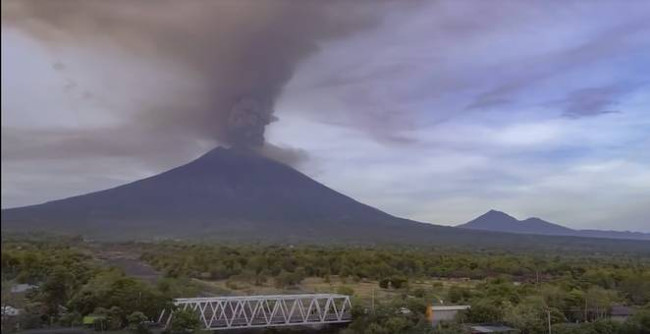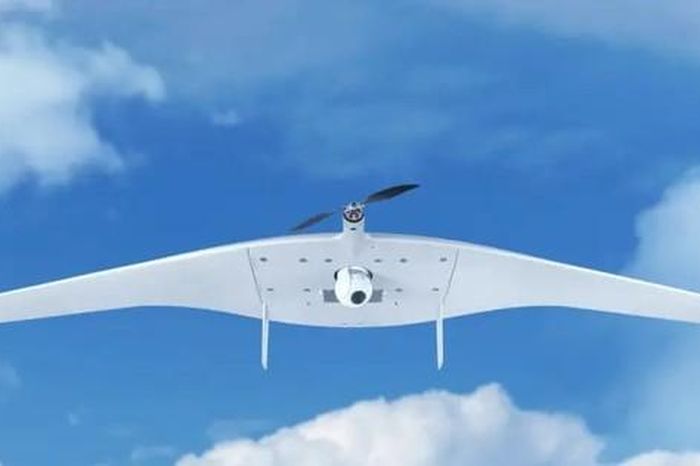Unmanned aircraft help predict volcanic eruptions
In Bali, Indonesia, researchers are hoping unmanned aircraft will help them detect and guard the next major volcanic eruption as well as reduce casualties and deaths.
Researchers from Aeroterrascan, an Indonesian unmanned aircraft manufacturer, have done two tasks.
On the first day, they used unmanned aircraft to create accurate 3D maps of the size of Agung volcano, accuracy of up to 20cm.

In the second mission, an unmanned aircraft is equipped with sensors that identify carbon dioxide and sulfur dioxide when flying through volcanoes. When these gases suddenly increased, this was a sign that some sort of eruption was about to happen. In this test, the level of this substance is high as a premise for the government to raise the warning level for volcanoes to the highest level.
The third task is that they use unmanned aircraft to scan the area around the volcano for those who need help to evacuate so they can escape danger.
These flights are not without risks. Some planes were lost during testing and they were not cheap to replace. After all, it is all necessary in an effort to increase the amount of active volcanic data so that people can be safer.
See more:
- Building the hair of the mysterious death of nine Soviet scientists
- Decipher the world's most dirty volcano that spits rotten mud instead of lava
- What is a UAV (drone), how does one control it and what can it be used for?
You should read it
- Unmanned aircraft help scientists monitor endangered sea turtles
- Watch American Athena laser weapons shoot down 5 unmanned aircraft
- Will there be unmanned aircraft approaching the Mars atmosphere in the future?
- Amazon will soon deploy an unmanned aircraft delivery project
- Intel teamed up with Ferrari to launch an integrated AI unmanned aircraft to analyze car races
- Memorize with the world record set of 1,374 unmanned aircraft
- Looking back at 27 years of development of the Boeing 777 - the best aircraft in the world
- How to repaint an entire aircraft?
May be interested
- Memorize with the world record set of 1,374 unmanned aircraft
 1,374 unmanned aircraft (drones) flew to the sky in the tourist city of xi'an (china) to establish a new guinness world record for 'the most simultaneous unmanned aerial gear' .
1,374 unmanned aircraft (drones) flew to the sky in the tourist city of xi'an (china) to establish a new guinness world record for 'the most simultaneous unmanned aerial gear' . - The Earth will cool when volcanic eruptions on Bali island erupt
 experts have discovered 700 tremors that happened in just one day, making them worried that this is a sign of volcanic eruption.
experts have discovered 700 tremors that happened in just one day, making them worried that this is a sign of volcanic eruption. - Intel teamed up with Ferrari to launch an integrated AI unmanned aircraft to analyze car races
 chipmaker intel has announced a partnership with ferrari north america to deploy a man-made aircraft using artificial intelligence to track car races.
chipmaker intel has announced a partnership with ferrari north america to deploy a man-made aircraft using artificial intelligence to track car races. - Decipher the world's most dirty volcano that spits rotten mud instead of lava
 the lusi volcano of indonesia's java island, abruptly erupting in may 2006 surprised the whole world and instead of lava, it spewed mud with a terrible smell. so far, after 11 years, lusi continues to erupt.
the lusi volcano of indonesia's java island, abruptly erupting in may 2006 surprised the whole world and instead of lava, it spewed mud with a terrible smell. so far, after 11 years, lusi continues to erupt. - Russia launched the SKAT 350M unmanned reconnaissance aircraft
 russian company kalashnikov concern announced that the skat 350m unmanned reconnaissance aircraft used by the russian military in special military operations will debut at the expotechnoguard exhibition in st. petersburg.
russian company kalashnikov concern announced that the skat 350m unmanned reconnaissance aircraft used by the russian military in special military operations will debut at the expotechnoguard exhibition in st. petersburg. - Transportation businesses use unmanned aircraft to provide medical supplies in the United States
 ups - the world's largest cargo delivery company and the leading provider of specialized shipping and logistics services, announced on tuesday, march 26 that they will begin conducting testing. drone project called wakemed, aimed at providing and transporting medical supplies in north carolina, usa.
ups - the world's largest cargo delivery company and the leading provider of specialized shipping and logistics services, announced on tuesday, march 26 that they will begin conducting testing. drone project called wakemed, aimed at providing and transporting medical supplies in north carolina, usa. - US military secrets were sold by hackers on Dark Web
 according to hackernews, confidential documents about the mq-9 reaper unmanned aircraft used in the us air force and navy, the royal air force, the italian air force, and some other specialized agencies were believed. the hacker stole and is being sold by a hacker on dark web - the underworld on the internet for only $ 200.
according to hackernews, confidential documents about the mq-9 reaper unmanned aircraft used in the us air force and navy, the royal air force, the italian air force, and some other specialized agencies were believed. the hacker stole and is being sold by a hacker on dark web - the underworld on the internet for only $ 200. - Review the 10 most devastating disasters in human history
 in human history, we have experienced many devastating disasters such as volcanic eruptions, earthquakes, tsunamis, snowstorms ... destroying the environment, robbing hundreds of thousands of people all over the world. place in the world.
in human history, we have experienced many devastating disasters such as volcanic eruptions, earthquakes, tsunamis, snowstorms ... destroying the environment, robbing hundreds of thousands of people all over the world. place in the world. - Boeing built an unmanned copter
 this copter successfully completed initial flight tests at boeing's cooperative autonomous system laboratory in missouri.
this copter successfully completed initial flight tests at boeing's cooperative autonomous system laboratory in missouri. - Indonesian volcano erupted, creating a column of smoke as high as nearly 200 meters
 on friday, anak krakatau volcano in indonesia exploded strongly, just like the mood of many of us during the period of social isolation!
on friday, anak krakatau volcano in indonesia exploded strongly, just like the mood of many of us during the period of social isolation!










 Plastic roads are capable of ... self-filling potholes in the Netherlands
Plastic roads are capable of ... self-filling potholes in the Netherlands How does sunlight become solar energy?
How does sunlight become solar energy? Play Mario with augmented reality technology right on the street
Play Mario with augmented reality technology right on the street Falcon Heavy - The world's most powerful super rocket can reach thrust of more than 2,300 tons
Falcon Heavy - The world's most powerful super rocket can reach thrust of more than 2,300 tons Magnetic cushion lifts: no cables are used, the first up, down, left, right in the world has appeared
Magnetic cushion lifts: no cables are used, the first up, down, left, right in the world has appeared Successfully decipher complex thoughts in the human brain
Successfully decipher complex thoughts in the human brain